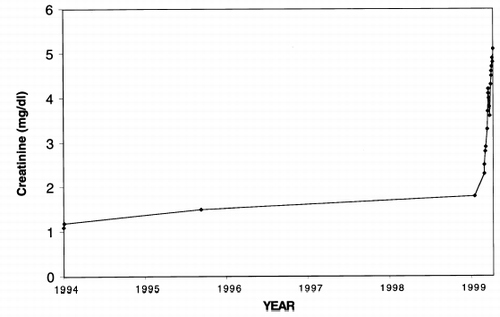Abstract
The relationship between acute renal failure (ARF) and long-term renal function remains unknown. We therefore undertook a study of patients at the Baltimore VA Hospital to examine the effects of a bout of acute renal injury on long-term renal function. We retrospectively reviewed the relationship between serum creatinine and time of observation for 6058 individuals who had values greater than 1.4 mg/dL in any two consecutive years. Individuals were stratified according to total years of observation with a minimum of two years. Severity of acute renal injury was divided into mild, moderate, and severe with elevations in baseline creatinine of <50%, 50–300% and >300% respectively. Sporadic elevations in creatinine were evident in 8–15% of the population. There were a total of 1328 episodes of acute renal failure in 916 patients that were suitable for analysis. Mild ARF on a substrate of normal or mildly abnormal renal function resolved without long-term sequelae. Moderate and severe ARF occurred more frequently on a background of reduced renal function but baseline function was retained in at least 60% of patients. We conclude that ARF is more frequent in patients with chronic kidney disease but it is not invariably associated with an accelerated course to end-stage renal disease or death. Overall, the majority of ARF events resolved without adverse long-term effects suggesting appropriate management in the majority of instances.
Introduction
Acute renal failure is a heterogeneous disorder that carries a grave prognosis when encountered in the hospital setting. A recent case control study found that acute renal failure increases hospital stay up to 23 days and the risk of dying by six fold.Citation[[1]] Community acquired acute renal failure also has a significant risk of morbidity and mortality.Citation[[2]], Citation[[3]], Citation[[4]] In one study, the mortality of patients admitted to the hospital with an acute increase in serum creatinine was 15%.Citation[[4]] Important risk factors for acute renal failure include hypertension when hypotension is an insult and prior renal insufficiency.Citation[[5]] Among the acute insults that can cause the disorder include aminoglycoside administration particularly in the elderly; dehydration; pigment induced injury; septic shock; and congestive heart failure. Of interest is the finding that, in the majority of patients, multiple insults are necessary to precipitate the clinical disorder while the number of insults are diminished in individuals with prior renal insufficiency.
In hospital mortality of acute renal failure can be as high as 80% and, in the setting of cardiac surgery, it is an independent risk factor for mortality.Citation[[6]] Other disorders that have a high incidence of acute renal failure include severe burns and rhabdomyolysis. While the short-term risks of acute renal failure have been well characterized, the risks for long-term renal function are not well known. Therefore, we examined a group of patients followed at the Baltimore VA Hospital who had acute deterioration of their renal function in order to evaluate long-term stability of serum creatinine.
Methods
Patients who were seen at the Baltimore VA Hospital between Dec 1, 1990 and Dec 1, 1999 and who had a serum creatinine greater than 1.4 mg/dL in any two consecutive years were used as the study group. Both inpatients and outpatients were included. In accordance with the Institutional Review Board policy, patients were assigned a random number, which allowed the investigator to examine the laboratory data without clinical information. Graphs of serum creatinine were prepared for each individual patient and these were reviewed by two physicians independently. Patients were stratified according to their total length of follow-up >2–3 years; >3–4 years; etc. The normal high laboratory value for serum creatinine was 1.4 mg/dL 1990–1992 and 1.1 1992–1999. The categories of classification included: sporadic elevations of creatinine, up to four such values with greater than 60% of values in the normal range; mild acute renal failure, increases in creatinine over a two week period <50% of baseline; moderate acute renal failure, increases in creatinine 50–300% of baseline; and severe acute renal failure >300% of baseline. Excluded from analysis were individual who had chronic stable renal insufficiency without acute deterioration, those with progressive renal failure and those individuals whose graphs were too complex for analysis. If conflicts arose they were resolved between the investigators or the graphs were placed in the category of “too complex.” Graphs were prepared using Excel.
Results
Of the 55,094 patients seen at the Baltimore VA between December 1, 1990 and December 1, 1999 20,047 had a least one creatinine value >1.4 mg/dL. The number of patients that had creatinine values greater than 1.4 mg/dL in any two consecutive years was 6058. This latter cohort served as our study group. This criteria was chosen to insure that all patients with significant progressive renal dysfunction were identified. Individuals were stratified according to total years of observation. This period included the time pre and post acute renal failure (ARF). Of the total group 541 were excluded because their graphs were too complex for analysis. Another 2583 were excluded because they had stable chronic renal insufficiency without evidence of an acute insult. A third group demonstrated a progressive increase in creatinine without a clear acute component, these patients numbered 629. A fourth cohort of 1389 patients had less than two years of follow-up and were excluded as well. The group that was left for study included 916 individuals. Of these 256 had two or more episodes of acute renal failure and 66 had more than two for a total of 1328 episodes. Shown in is a graph of serum creatinine of an individual with a sporadic increase in creatinine values followed for a period of five years. This patient had two values greater than 1.4 mg/dL during this time period. Individuals followed for >2–3 years had a 12% incidence of sporadic increases in creatinine . This value remained relatively constant at 8–15% despite an increasing duration of observation.
Figure 1. Serum creatinine vs. time of observation for an individual with sporadic elevations of serum creatinine. This individual was followed for nearly five years and had two values >1.4 mg/dL while 87% of values were ≤1.4 mg/dL.

Figure 2. Percent of patients with sporadic increases in serum creatinine observed for various time periods. Increases in creatinine were >1.4 mg/dL with 60% of values ≤1.4 mg/dL.
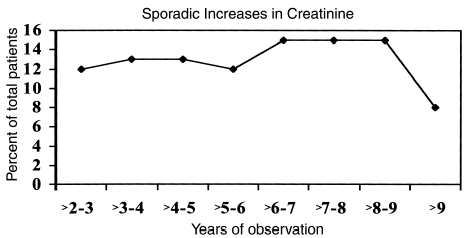
Individuals with mild acute renal dysfunction, an increase in creatinine <50% of baseline over a two week period were subdivided into three subcategories. These included individuals with a normal baseline who returned to a baseline that was in the normal range. At least six months of follow-up had to be documented before and after the acute renal failure episode. The second subcategory included those individuals with pre-existing renal dysfunction serum creatinine 1.4–2.0 mg/dL who returned to their baseline. The third group of patients, included those individuals who had a normal baseline initially whose post event creatinine returned to a range of 1.4–2.0 mg/dL. These results are illustrated in . Those individuals with mild acute renal failure on a substrate of normal renal function and who returned to normal renal function ranged between 2 and 3% except for the last two periods. The years of follow-up are the total number of years for which there was data. The percentage of individuals with preexisting renal dysfunction who returned to their baseline following acute renal injury was low and stable. Those individuals who had a normal baseline pre acute renal failure and who increased to a baseline that was abnormal constituted a very small group. Those individuals with a normal serum creatinine that established a baseline >2.0 mg/dL was also very small (data not shown).
Figure 3. Percent of total patients with mild acute renal failure (serum creatinine increase <50% of baseline). ♦—individuals with normal baseline renal function who returned to a normal baseline. ▪—baseline creatinine 1.4–2.0 mg/dL who returned to that level after a bout of acute renal failure. ▴—individuals with a normal baseline who returned to a baseline 1.4–2.0 mg/dL.
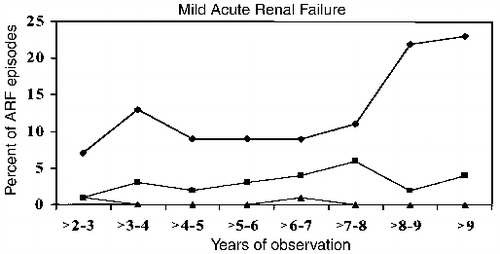
The second major group of patients who were examined were those with moderate acute renal failure, creatinine values >50–300% of baseline. These individuals were subdivided into groups as discussed above. The results of the whole group are displayed in . The largest percentage of these patients tended to be those with either a prior normal baseline or those with moderate renal dysfunction who returned to their baseline. Individuals with prior normal renal function and a long-term impairment of renal function after an acute insult, averaged about 1% of the totals.
Figure 4. Percent of total patients with moderate acute renal failure (serum creatinine increase 50–300% of baseline). ♦—individuals with normal baseline renal function who returned to a normal baseline. ▪—baseline creatinine 1.4–2.0 mg/dL who returned to that level after a bout of acute renal failure. ▴—individuals with a baseline 1.4–2.0 mg/dL who returned to a baseline of greater than 50%. *—patients with no follow-up after acute renal failure. ×—individuals with normal renal function who returned to a baseline 1.4–2.0 mg/dL.
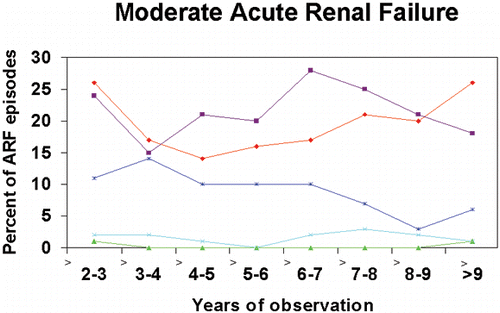
Another cohort of patients emerged from this group. These were individuals that had acute renal failure but had no follow-up after their insult. It is likely that they included those who either died or those who were transferred to another facility.
The last category were those patients with severe acute renal failure, >300% of baseline. An example of this group is illustrated in . The majority of these patients had normal baselines prior to their acute renal failure and returned to normal baselines . However there was a substantial number of those individuals with prior normal or abnormal renal function who appeared to have a bout of terminal severe acute renal failure. An example of this group is shown in . There was also groups that had higher residual renal dysfunction after their bouts of acute renal failure regardless if the starting baselines were normal or abnormal.
Figure 5. Serum creatinine vs. time for an individual with severe acute renal failure (serum creatinine >300% of baseline) on a substrate of abnormal renal function followed for more than eight years.
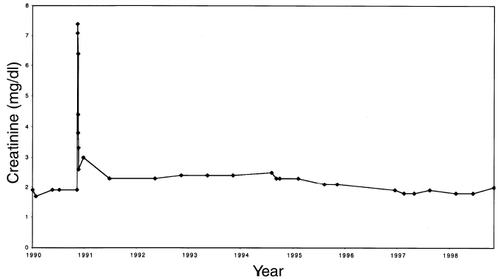
Figure 6. Percent of total patients with severe acute renal failure (serum creatinine >300% of baseline). ♦—individuals with normal baseline renal function who returned to a normal baseline. ▪—baseline creatinine 1.4–2.0 mg/dL who returned to that level after about of acute renal failure. ▴—individuals with a baseline 1.4–2.0 mg/dL who returned to a baseline of greater than 50%. *—patients with no follow-up after acute renal failure. ×—individuals with normal renal function who returned to a baseline 1.4–2.0 mg/dL.
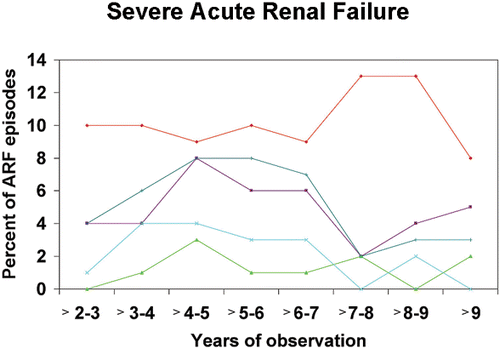
Discussion
The purpose of this study was to provide some insight into the importance of acute renal failure as an etiology of chronic renal disease. In order to assure accuracy of the results, two physicians reviewed each graph and they had to agree on the categorization or it was included in the “too complex” group. The success of this strategy is evident by the consistence of the data. The population selected was one of relatively high risk since the criteria were that a high or frankly abnormal value was required in two consecutive years. The results indicate that a significant number, 8–15% of patients, had sporadic elevations in creatinine.
It was reassuring that progression of renal dysfunction was not evident in these individuals. On the other hand, 12–14% of patients demonstrated a progressive deterioration in renal function (data not shown). One by-product of computerization should be that we will be able to identify these individuals sooner and take appropriate action.
Individuals with an episode of mild acute renal dysfunction returned to their baseline values regardless if they had pre-existing renal disease or not. Most of these cases likely represented pre-renal dysfunction which is the predominate etiology of acute elevations in creatinine. Thus, the data support the notion of reversibility in the majority of cases of mild renal dysfunction. One problem with this study is that we did not define the length of follow-up after the bout of renal dysfunction. However, if we assume a normal distribution of events, then the individuals observed for the longest period are also those likely to have the longest post event follow-up as well.
When surveys are restricted to the hospital and acute renal failure is defined as an increase in creatinine of 20–50% or > 0.5 mg/dL, mortality of 20–30% is observed.Citation[[7]] Our data imply a much more benign outcome of acute renal failure with modest elevations of creatinine; however, it must be noted that we excluded individuals with multiple shifts in renal function because of the difficulty in their categorization. In addition, by including patients followed as outpatients there was a large number of individuals with lower rates of co-morbidity. It is well known that these groups have a much better prognosis.
Those individuals with moderate acute renal failure comprised the largest group that we studied. Here as well, the majority of those with a normal baseline as well as those with an elevated baseline of creatinine returned to those levels after the episode; however, there was an increased incidence of those patients whose baseline was higher after the event when compared to those with mild acute renal failure. In this group we also saw the emergence of a group of patients who had no follow-up after the acute insult. It is likely that the majority of these individuals represent in-hospital mortality or end-stage renal disease. When survival of acute injury is factored against a rise in serum creatinine, there is a near linear inverse relationship which appears to peak around an increase of serum creatinine of 3–3.9 mg/dL.Citation[[7]] Our data is consistent with these observations.
The last group that we studied was those patients with severe deterioration of renal function. Evident in this group was a small but consistent number of individuals with higher baselines after the episode. This finding likely reflects the greater severity of the acute renal failure. In keeping with this notion we observed individuals with end of follow-up functional deterioration.
It has been noted that the mortality of severe acute renal failure has not changed in 50 years. While this may be true, the results of our study suggest that there are large numbers of patients that suffer acute deteriorations of their renal function who recover that function and are left with few sequelae. The data for those individuals with moderate or severe acute renal failure at the end of follow-up is expected since they lose renal function along with the deterioration of other organ systems. While there is a great deal to learn about the pathogenesis of acute renal injury and its therapy, it appears that the majority of patients received appropriate management.
Acknowledgment
The authors would like to thank Geetha Stachowiak for her assistance in assembling the manuscript.
References
- Shusterman N., Strom B.L., Murray T.G., Morrison G., West S.L., Maislin G. Risk factors and outcome of hospital-acquired acute renal failure. Am. J. Med. 1987; 83: 65–71
- Feest T.G., Round A., Hamad S. Incidence of severe acute renal failure in adults: results of A community-based study. B.M.J. 1993; 306: 481–483
- Liano F., Pascual J. The Madrid Acute Renal Failure Study Group. Epidemiology of acute renal failure: a prospective, multicenter, community-based study. Kidney Intl. 1996; 50: 811–818
- Kaufman J., Dhaka M., Patel B., Hamburger R. Community-acquired acute renal failure. Am. J. Kid. Dis. 1991; 18(2)191–198
- Rasmussen H.H., Pitt E.A., Ibels L.S., McNeil D.R. Prediction of outcome in acute renal failure by discriminant analysis of clinical variables. Arch. Intern. Med. 1985; 145: 2015–2018
- Chertow G.M., Levy E.M., Hammermeister K.E., Grover F., Daley J. Independent association between acute renal failure and mortality following cardiac surgery. Am. J. Med. 1998; 104: 343–348
- Hou S.H., Bushinsky D.A., Wish J.B., Cohen J.J., Harrington J.T. Hospital-acquired renal insufficiency: a prospective study. Am. J. Med. 1983; 74: 243–248

